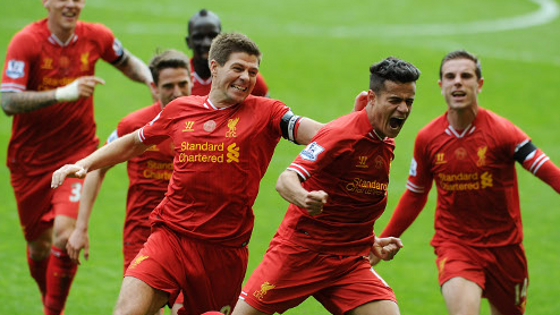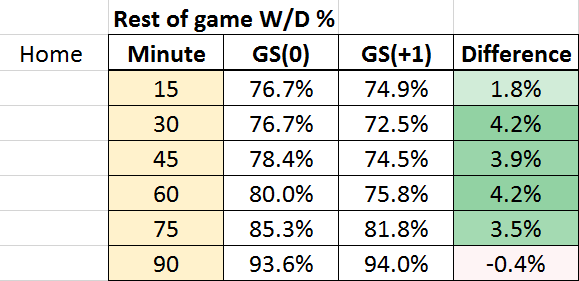It’s human nature to want to avoid risks and losses, whether it is financially, emotionally, or even in our beloved sports, yet it can often be sub-optimal for us to do so. Golfers often putt better when putting for par compared to putting for birdie. The prospect of a gain from a birdie is weighted less important than avoiding the loss from a bogey, so when accounting for difficulty, about 3.6% more par putts are made than birdie putts. American football teams punt too frequently on 4th Down since a turnover on downs is considered a major loss by the offence whereas a punt is considered an avoidance of this "offensive loss". These two completely different sports are affected by the same psychological behaviour and it won’t surprise you to hear that football is just the same.
Game States
So how can we distinguish loss aversion in football? If loss aversion was a part of football you would expect teams to perform worse when they have a lead, or “something to lose”. To check whether loss aversion is prominent we can see how teams perform in different game states, if teams perform worse than expected when they're a goal up then it would seem that loss aversion is indeed prominent . There have been a few different posts about game states 1 2 3 4 which I’d recommend reading if you haven’t already. Most of them seem to focus on how it affects shot numbers and conversion, but don’t really explain how it actually affects game outcomes, so that's what I'm going to attempt to do.
I'm probably going to be writing about different game states a lot so I'll define some basic shorthand.
GS(0) = Team is drawing with opponent
GS(+1) = Team is leading by 1 goal
GS(-2) = Team is losing by 2 goals etc.
Ben Woolcock’s research shows that teams that were up by a goal in the premier league between 2010 and 2014 scored 50.6% of the goals from this game state. But does that mean teams that go up by a goal are playing optimally since they are scoring more goals, or would you expect them to be scoring a higher proportion since the team in GS(+1) is often the superior team.
Using bookmakers odds (I used the 13/14 and 14/15 EPL seasons) and assuming a Poisson distribution for goalscoring rates we can calculate the proportion of goals you would expect each team to score in a given match, assuming that they don't change their style of play depending on game state. From this you can also calculate the proportion of goals you would expect from a team in GS(+1) which I’m going to refer to as EXP(+1)%.
You can assign “p” (the proportion of goals the home team would be expected to score from bookmakers odds) to be the probability the home team scores any given goal, and “q” the probability the away team scores any given goal. There are a couple assumptions we're going to make when calculating our expected proportion of goals scored from GS(+1):
- I'm assuming that every game during the 13/14 and 14/15 EPL seasons only had 1 goal from GS(+1). This means games that ended with 0 or 1 goals are counted and games that had multiple goals from GS(+1) are only counted once. Since close games tend to be lower scoring this would mean that games with a EXP(+1)% near 50% will probably be weighted higher than they should be, so overall EXP(+1)% will most likely be higher than the value we will calculate.
- I also assumed that each game had a goal rate that followed a Poisson distribution with expected number of goals = 2.67, which was the average number of goals per game over the the 13/14 and 14/15 seasons. Although the best estimate for expected number of goals will fluctuate slightly around 2.67 from game to game, this shouldn't have too much of an affect on the p and q values.
Calculating EXP(+1)%
At the start of a match in order for a team to go into GS(+1) and then score again it has to score 2 goals in a row so let's work out the probability of this. The probability that the home team scores to go into GS(+1) and then scores from GS(+1) can be calculated by p2 (or p*p) and therefore it can be calculated as q2 for the away team. If we add these two together we get the expected proportion of goals that a team in GS(+1) should score
EXP(+1)% = p2 + q2
Therefore if both teams were even then, p=0.5, q=0.5 and EXP(+1)%=(0.5)2 + (0.5)2 = 0.5
Or if the home team was expected to score 65% of goals then EXP(+1)%=(0.65)2 + (0.35)2 = 0.545
Also EXP(+1)% is the same for constant p and q no matter which type of GS(+1) you are in (1-0, 2-1, 3-2 etc.) the more mathematically inclined can figure out why for themselves if they fancy a little exercise.
I calculated p and q values for every premier league game over the past 2 seasons and averaged out the EXP(+1)% of each game, with the assumptions previously stated. It turns out that based on the 13/14 and 14/15 EPL seasons the average proportion of goals you would expect from a team in GS(+1) is 55.3%, which is much higher than the 50.6% figure found by Ben Woolcock in the EPL as well as the 49.2% figure found by 11Tegen11 in the Eredivisie. So when teams get a lead they tend to perform worse than expected and consequently the team that falls behind performs better than expected. This is a pretty big drop in performance which seems in line with my original assumptions of loss aversion being significantly prominent in football.
Expected results from different Game States
So it seems like we've found a good indicator of loss aversion in football but how else can we show it's prevalence? When you’re leading by a goal the main incentive isn’t to maximise your chances of scoring the next goal, it’s to maximise your chances of winning the game which can be achieved without any more goals being scored. This is the reason why shelling is so prominent during GS(+1) situations. To account for this we need to look into how teams perform over the rest of the game when up by a goal compared to when level.
I used the win expectancy chart from American Soccer Analysis to see how teams played in different game states during different periods of games over the last 5 MLS seasons.
When in GS(+1) the priority of the team is to either win or draw the rest of the game, in order to win the game outright. I looked at the rate at which teams in GS(+1) won/drew the rest of the game compared to how often teams in GS(0) did the same.
Or in other words, assuming the score goes back to 0-0 after X minutes, how often did teams entering the Xth minute in either GS(0) or GS(+1) win/draw the rest of the game.
Remember that in general you would expect the team that is in GS(+1) to be the superior team, so even if the win/draw percentages were the same then that would be an indicator of loss aversion taking place.
In fact what we see is completely against intuition, that teams in GS(0) actually outperform teams in GS(+1) over the rest of the game. Now this doesn't tell us whether teams were actually shelling or just became too defensive without any structure but the fact that teams in GS(0) actually play better than teams in GS(+1) (especially the away teams) is a sign that playing defensively when up by a goal may in fact be a pretty bad idea. Another argument may be that shelling isn't bad but teams perform better when a goal down because they attack more aggressively, if this is the case then the conclusion is still the same, teams just generally aren't being attacking enough.
Practicality
But can you teach a team not to be loss averse in order to improve performance? If Liverpool's 2013/14 season is anything to go by then I'd like to think the answer is yes. Okay, that season will forever be remembered for Gerrard's infamous slip that handed Man City the title, but Liverpool far exceeded any preseason expectations and their attacking style of football was the reason behind it.
Liverpool scored 101 goals and conceded 50 that season so on average their proportion of goals was p=0.67 and opposition goals q=0.33. Liverpool games had an average of 4 goals, whereas all other games had an average of 2.5. So how many points would Liverpool expect to have if their games had a league average rate of goals? We've seen how being defensive decreases the proportion of goals a team scores but let's assume for now that the p and q values stay the same.
I can't really account for loss aversion affecting performance but I can account for the number of points earned from winning matches instead of drawing them just by playing attacking football. Using a win probability model and calculating the difference between games with 4 goals and games with 2.5 goals, Liverpool gained an extra 0.185 points per game or just over 7 points over the course of the season, the difference between them challenging for the title and finishing behind Arsenal in 4th. I must add that this would only really work for top half teams although this is without taking into consideration the positive performance effects that attacking play seems to have.
Just like golf, American football, and a whole array of other sports, football is subject to loss aversion. So for the benefit of the teams (and the benefit of the fans) let's hope we see more attacking football from clubs in the near future.
Edit
Not really sure how I forgot to mention Leicester but they are another prime example of the success of playing more open, attacking football (especially against teams that are considered inferior) and minimising loss aversion. Similar to Liverpool in 13/14 Leicester have been aggressive going forward, leading to their games consisting of a league high 3.7 goals per game and helping them defeat teams that they probably would have drawn against in low scoring games (3-2 vs Villa, 4-2 vs Sunderland, 3-2 vs West Brom).
It will be interesting to see how Leicester adjust with a difficult run of upcoming fixtures, since you would usually want a lower number of total goals against teams that you consider better. You could argue however that with the boost in general performance that this attacking style has brought, Leicester may even consider themselves as favourites at home to the likes of United and Chelsea, and with the way in which each of these 3 teams have been playing recently it'd be difficult to argue otherwise.


